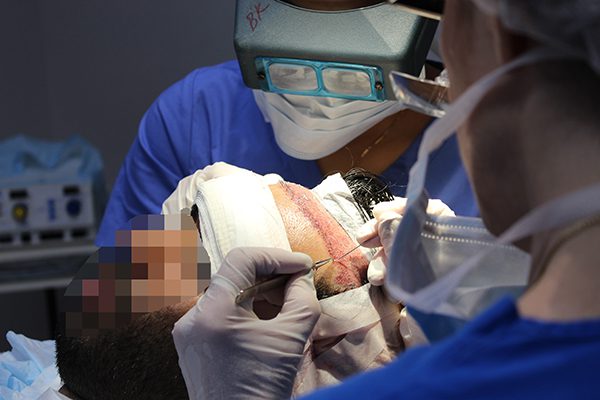How Is Hair Transplant Performed

When you really “boil it down,” a hair transplant is simply a “moving” procedure. The real goal of a hair transplant is to effectively move healthy follicles from a region of the scalp where they are abundant – the “donor area” – to a region where they have thinned or completely disappeared – the “recipient area.” In other words, a successful hair transplant is measured by how well follicles are moved from one region to another. While this may sound simple, hair transplant surgery is a specialized and meticulous process which takes a highly skilled and trained team to complete. To be successful, this process must be performed in series of organized steps. These steps can be broken down into:
- Surgical design and planning
- Donor preparation and graft removal
- Microscopic graft preparation
- Recipient site preparation and creation
- Graft placement (implantation)
Surgical Design and Planning
The hair transplant process begins with the surgical design and planning. During this phase, the hair transplant doctor will carefully evaluate the patient’s scalp, level of hair loss, and facial features, and come up with a surgical plan. Next, goals and limitations are discussed and lines are drawn on the scalp indicating where the new hair will be placed. It may sound simple, but the surgical design and planning is arguably the most important part of the day; especially when frontal hairline work is being performed and an entirely new hairline must be designed. During this process, the doctor will also evaluate the donor region – where the donor follicles will be removed – and begin to formulate a harvesting plan.
Donor preparation and Graft Removal
After the surgical plan is complete, the patient is taken to the procedural suite (operating room) where his or her scalp is cleaned and the donor area on the sides and back of the scalp is trimmed. The doctor will then further evaluate the donor region and determine from where in this safe donor zone the follicles will be removed. The safe donor zone is a small, defined area on the sides and back of the scalp where the hair follicles are “immune” to hair loss. The doctor must carefully evaluate and only remove follicles from this safe donor zone to ensure the transplanted follicles will last indefinitely after being transplanted. The donor area is then numbed using “local anesthesia” (the same medication the dentist uses to numb the mouth) and tissue is removed. The follicles can be removed via two main methods:
- Follicular Unit Transplant (FUT or “strip” technique)
During FUT, a narrow strip of hair-bearing skin is removed via a single linear incision and then closed using stitches or staples. - Follicular Unit Excision (FUE – previously known as Follicular Unit Extraction)
During FUE, small punch tools are used to remove follicles individually (“one-by-one”). The empty holes created by follicle removal are then left open to heal into circular scars.
Microscopic Graft Preparation
Next, hair transplant technicians begin to examine the newly removed grafts under high-powered microscopes and prepare these follicles for implantation. If an FUT procedure is being performed, the technicians will carefully dissect the strip into individual “follicular units.” Follicles naturally grow in groupings of 1 to 4 hair “follicular units” in the scalp, and they must be dissected into these same natural units for proper transplantation. The ability to prepare these follicular units with surgical precision under microscopes creates the highest quality grafts. During an FUE procedure, the grafts are removed individually so there is no real dissection under the microscopes. However, the microscopes should still be used to trim, examine, and properly categorize the FUE grafts.
Recipient Site Preparation and Creation
Next, the doctor will prepare the “recipient region” where the new grafts will be implanted. The first step is to numb this region with the same local anesthesia used in the donor area. Next, the doctor will use tiny tools (typically custom cut blades or needles) approximately one millimeter in width to make thousands of incisions in the bald scalp. These incisions – or “sites” – are made in specific directions, densities, and patterns to recreate a full and natural appearance. The doctor also uses different sized tools to make slightly smaller incisions in the new hairline region. This is because only smaller, single hair follicular units can be used to recreate a soft, natural frontal hairline.
Graft Placement
After all the grafts are prepared and the recipient site incisions have been created, the team now must place the follicular units into the sites (“implantation”). During this process, technicians traditionally use fine-tipped forceps (“tweezers”) and needles to carefully grasp each graft and gently slide them into each incision site. Since the average hair transplant case consists of thousands of grafts, it is easy to understand the dedication and focus a hair transplant technician must have to expertly place each graft without damage. After all grafts are placed the case is complete.
The patient is then provided with post-operative instructions and a short course of antibiotics and pain medications. The patient then goes home to rest and recover. If the patient underwent an FUT procedure, he/she will have their stitches or staples in the donor region removed approximately 10 days after surgery.





